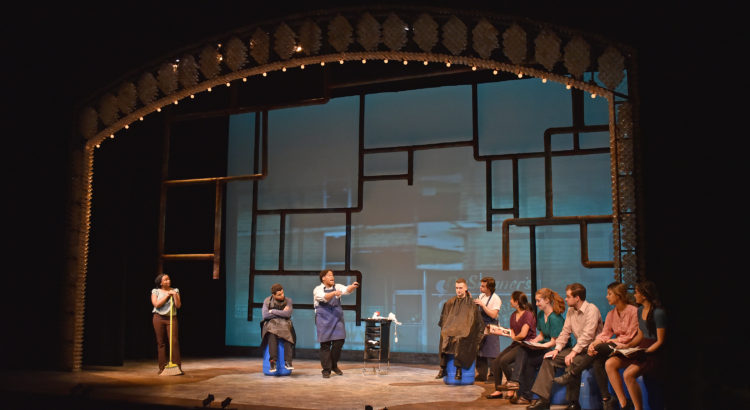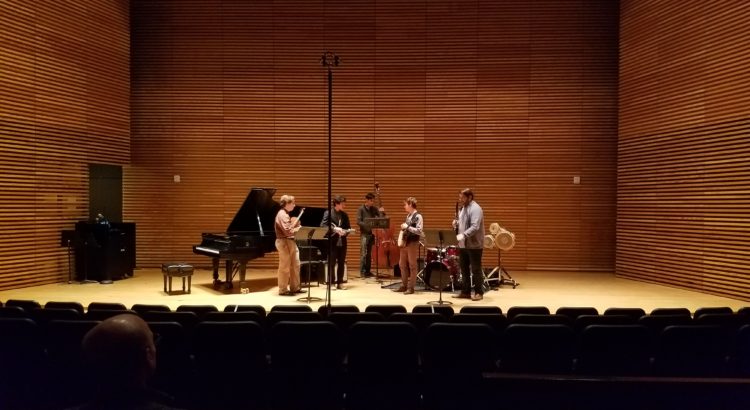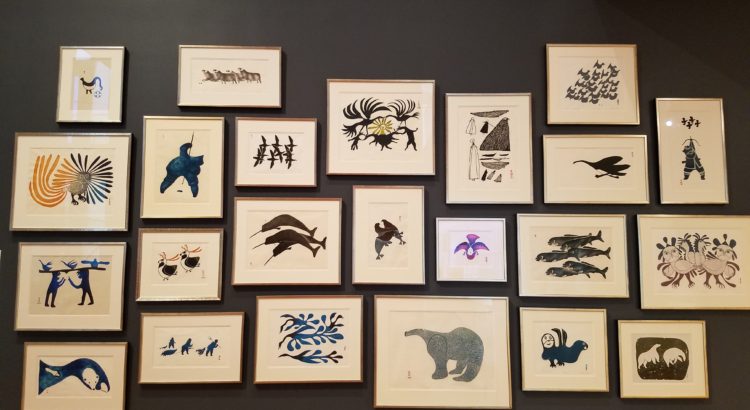The Aftermath follows life after World War II in Germany as an American officer’s wife comes to live with him in a house already occupied by a German man and his young child. This movie takes a look at a part of the war we don’t usually think about and displays the complicated process of transitioning life in Germany when many Nazis were still on the loose and some remnants of the war still remained. The movie stars Kiera Knightley, Alexander Skarsgard, and Jason Clarke in what looks to be a scandalous love triangle.
I haven’t heard fantastic things about the movie. However, I’m a sucker for period dramas – especially when Keira Knightly is in them. And with finals and graduation looming ever nearer, a little scandal and romance are welcome distractions. The Aftermath is playing in the Michigan Theater for a limited time so make sure and get out to see it this week while you can!
Author: audreymg

PREVIEW: FLINT
A new play is being put on by the school of music, theater, and dance called FLINT. The play was written by Professor Jose Casas and was the result of a collaboration with Umich students and volunteers from Flint. The play is meant to resemble a documentary and tell the complex story of Flint residents’ experiences with the water crisis. Casas wrote the play based on over 80 interviews with Flint residents, some of which he searched out and others he stumbled upon by happenstance. The project began over a year ago and has involved students interested in what is referred to as social justice theater.
A classmate of mine is one of the actors and shared with me the anxiety he and his colleagues felt about their debut. He shared a worry that comes hand in hand with social justice theater, are we serving the community or exploiting it? For my classmate, this fear culminates on April 16th when the troupe will be performing in the play’s namesake.
I must admit, hearing about this anxiety gave me hope. A group fueled by such good intentions and so concerned with the impact of their work will surely do the story of Flint justice. If you want to see FLINT make your way over the Arthur Miller theater between now and April 14th to see what’s in store.
Image courtesy of university productions.

REVIEW: Chamber Jazz Ensemble
This was my first time going deep into the belly of the school of music theatre and dance for the chamber jazz ensemble performance. I said that I wanted to experience some new jazz and that is definitely what I experienced Monday night. The first ensemble (featured in the picture above) was definitely the furthest stretch from what I consider jazz. It seemed a lot more like a bluegrass group based on instrumentation as there was a violin, mandolin, and banjo in addition to the upright bass, drum set, and clarinet. They called themselves Knit & Wool which only added to their Mumford and Sons vibes. Their first piece was confusing. It featured a lot of clapping and latin vibes making it sound more like flamenco than jazz to my ears. There seemed to be so many pieces trying to fit together and I just couldn’t decide if it was successful in my mind. However, their second piece was amazing. The mandolin player composed the second piece which made it even more exciting and made me wonder if this strange ensemble had been formed as an experiment to test out his composition. The piece was beautiful, very melodic and meandering, successfully pulling together overlapping melodies without sounding chaotic. It felt like summer and adventure to me and I couldn’t help but smile throughout the show.
The second ensemble was very 50s jazz with a big band vibe, featuring sax, trombone, trumpet, guitar, bass, drums, and vocals. I’m generally not super into jazz with vocals, I tend to listen for the instrumental aspect of the music. However, I think the vocalist was my favorite part of this ensemble. She looked the part and her voice was beautifully interesting and jazzy. The two pieces they played were arranged by the performers themselves with the first being arranged by the trombone player and the second by the saxophone player. The trombone and trumpet players were both women and I love it when women play stereotypically masculine instruments. However, I was originally surprised when the trombone didn’t play a solo in the piece which she arranged. It became clearer to me after listening to the second piece when she played an extra long solo. The second piece was Cherokee by Kamasi Washington which I hadn’t heard before but I know Washington which made me feel like quite the jazz fan.
The last ensemble was not as printed on the program but we were all the better for it. They walked on the stage and instantly oozed “cool”. The pianist had an afro, long sideburns, and wore round sunglasses indoors making him look straight out of the 70s. They introduced themselves as the bassist (I couldn’t quite hear his name) and the minorities aka the bassist and the majorities aka, aka, aka… they had many different aliases. This ensemble featured piano, drums, bass, guitar, alto and tenor sax, and trumpet. The first piece that they played was so modern jazz. It was chaotic and dissonant and reminded me that I really do need to expand my jazz horizons. They threw me for a loop in the middle though when it suddenly changed to sounding like a classic jazz combo. I leaned over and asked my boyfriend if they had transitioned into a second piece without pausing because it felt so different. The piece eventually looped back around to its chaos before ending. The second piece really brought it home featuring the great trumpet player and guitarist. You could feel real synergy on the stage and knew that they enjoyed their instruments and playing together.

REVIEW: Tillirnanngittuq
Why is the UMMA so difficult to navigate?? If you aren’t looking at one of the main exhibits it is just a maze of half levels and random staircases. However, if you manage to find your way through and follow the signs for the Buddhism exhibit, you will find the Power family’s Inuit art collection. It is a fairly small collection, filling on room comfortably. Everything is one of two media, prints or sculptures. The first piece I saw entering the exhibit was a sculpture of two intertwined narwals with their bodes carved out of a beautiful, blueish granite and their horns out of ivory. This was probably the largest of the sculptures and certainly held a place of honor. I really like multi media sculptures; Degas’ dancer sculptures have always been favorites of mine as he uses ribbon and tulle to create a more realistic, and textural representation of his subjects. The Inuit sculptures utilized a similar technique by using ivory and horn to represent tusks, teeth, and horns on their sculptures. This added something extra to the art and made it feel connected with the real life animals that they represented.
The other art form featured in the exhibit was prints. The gallery wall featured some twenty, framed prints of various hues and subject matter arranged on one wall together. Next to the gallery wall was a stone print block for one of the prints on the wall. I generally think of prints being carved on wooden blocks or maybe a plastic like vinyl but many of these prints were carved into stone or ivory. The prints on the wall mainly featured animals and fed into the general hue of the room as many were printed in black or shades of blue while the sculptures were mainly carved out of stone on the black and blue color spectrums. The prints were interesting individually but also as a collection altogether. Many of the prints featuring birds were at the top while polar bears were at the bottom. To my mind, they were roughly arranged so as to put predators at the bottom and prey at the top. Two prints in particular were placed alongside each other creating a story. One print featured a flock of birds while the print next to it featured a smaller flock of similar birds and a hunter with a bow pointed at the birds above them. This interplay between the prints really displayed the beauty of good curation as those prints did not seem to be made by the same artist or necessarily intended as a pair but added something to the gallery when featured as such.
PREVIEW: Chamber Jazz Ensembles
Be sure to make it out for tonight’s performance of the school’s chamber jazz ensembles. The performance is at 8pm in the Stamps Auditorium of the Walgreen Drama Center. The event is totally free as one of the School of Music, Theatre, and Dance’s over 900 annual shows. The college offers many different opportunities students and faculty from both within SMTD and without to participate in chamber ensembles of various size, genre, and difficulty level.
I’m excited to go to this performance as an amateur jazz lover always looking to expand my knowledge and taste in jazz. I’m hoping for there to be a big band style ensemble as I’m hoping to branch out a bit from my typical taste in jazz which is mostly smaller ensembles from around the 1950s. Most of my experience with modern jazz has been Kenny G or the horrible “watercolors” smooth, elevator jazz station my parents love, so my impression of jazz after the 1960s is generally abysmal. I know that there has to be good modern jazz out there though so hopefully this performance will be a step in the right direction and introduce me to some new sounds and composers.

REVIEW: Wang Qingsong/Detroit/Beijing
The corner, glass exhibit of the UMMA always holds something new and exciting. Watching it change from season to season is a small way that tired students passing by can experience a little bit of art. When the giant moon balloon was deflated and taken away bright, Chinese writing began appearing on the glass. Like many of my classmates, I was curious what lay inside and took time to venture inside. The Wang Qingsong/Detroit/Beijing exhibit is a recreation of a 1959 drawing by Wang Shikuo. This drawing told the narrative of peasants uprising against their landlord and claiming their rights to the land. Qingsong’s photography project recreates this narrative in Highland Park, a small city in the heart of Detroit. The project was originally meant to be recognized in Beijing but after visiting Michigan the artist was inspired. The exhibit itself features the final photograph and components of the journey to creating it. The Chinese phrases on the glass walls are taken from banners featured in the photograph while the two garments in the center of the room are also featured in the photograph. One garment is a coat in a traditional Chinese style but the fabric is made from a patchwork of American and Chinese clothing tags. The other garment is the bloodstained shirt featured at the center of the photograph. The project is meant to create unity between the communities of Detroit and Beijing in a conversation about capitalism and activism. The photograph is set in an abandoned Highland Park factory and features over 70 volunteers including locals. My favorite aspect of the exhibit was the coat made of tags. It was a great detail that really accentuated the power of consumerism on society.

